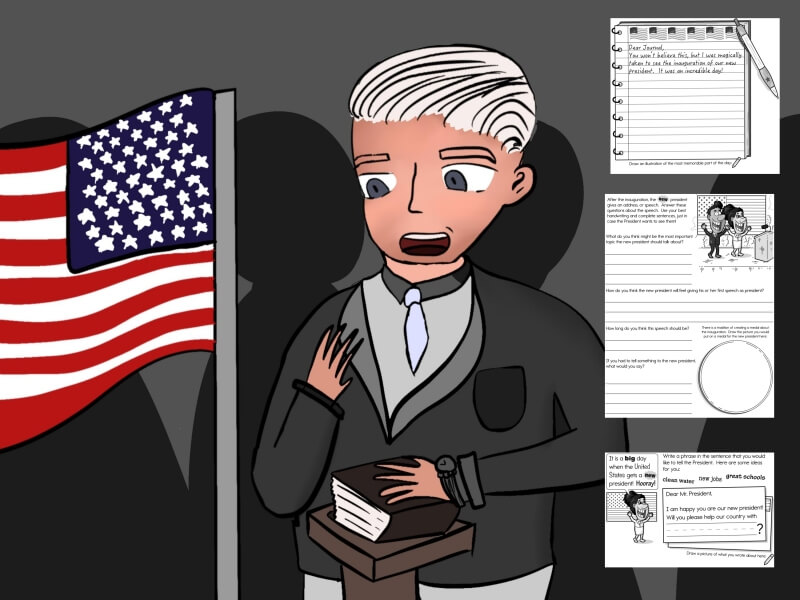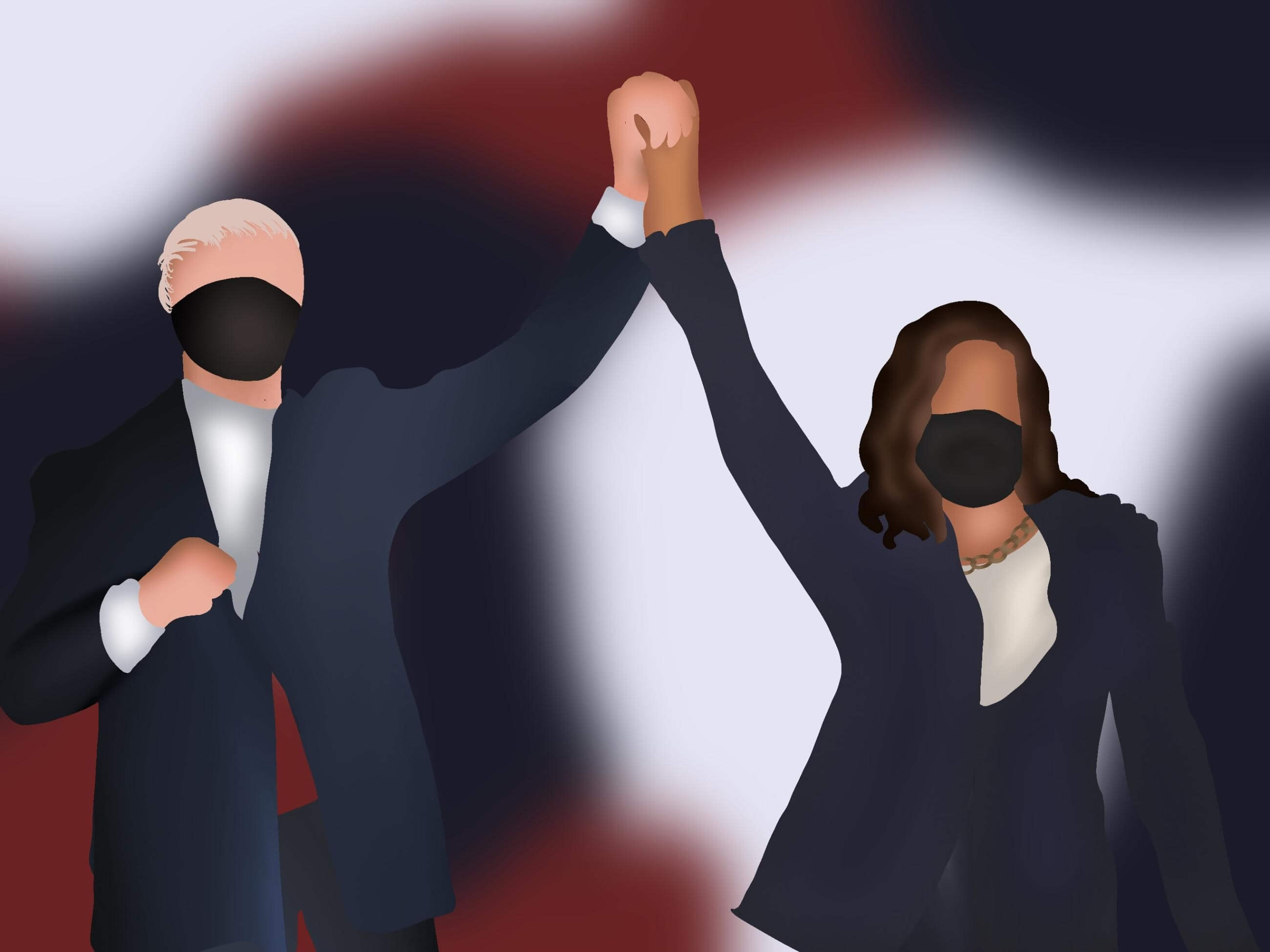Free Inauguration Day Workbooks for your class:
Inauguration Day 2021 Activities

Take advantage of this historical event and help your students understand its significance by looking at inaugurations from the past, present, and future. Quick, easy-to-implement lesson ideas and resources are ready for you!

Every four years, January 20th becomes more than just a cold day in the middle of the post-holiday season of letdown. This day almost magically transforms into a joyous occasion complete with parades, fancy balls, concerts, and festive celebrations, at least for the portion of the country that voted for the newly elected president. January 20th is Inauguration Day.
The 20th amendment states that January 20th must be designated as Inauguration Day. Every January 20th, if it follows a presidential election the previous November, the new president raises his or her right hand at noon and takes an oath to become the new (or returning) president of the United States of America.
Whether you are still teaching online or back to in-person instruction, there are several things you can do to support your students' understanding of the inauguration and its role in history, while having a little fun!
Looking Back at the Past
The inauguration is an ideal time to look back at American history and recall previous presidencies and times. The following activities will help your students reflect on the past.
#1 - A Trip to the Library
The Library of Congress hosts a website filled with primary sources from each of the previous presidents' inaugurations. Have students work individually or in small groups to select and research one of the previous 45 Commanders-in-Chief. Whether in breakout rooms or around a desk, have your students create a brief PowerPoint presentation or poster answering the 5 W's (Who, What, Where, When, and Why?) about a previous president.
#2 - Rewind and Review
The Joint Congressional Committee on Inaugural Ceremonies (JCCIC) is responsible for planning and executing the presidential inaugural ceremony at the Capitol. Students can visit the JCCIC website to learn about the committee members and details of previous inaugurations. Students can take a step back in time through engaging photographs and full-length videos to see what past presidents and guests wore and ate during the celebrations and view speeches and parades. Which inauguration do they wish they could have attended? Encourage them to write a brief narrative about their chosen inauguration and support their reason for wanting to attend with details from the site.
#3 - Powerful Poetry
A recent addition to the inauguration ceremonies is poetry reading. Several well-known poets have written and recited their work during inaugurations. Invite students to listen to or read the poems. They can respond by analyzing the poems' purpose. You can use the poetry for a close reading exercise or ask students to complete a performance task, such as the ones created and compiled by Teaching Tolerance, a project of the Southern Poverty Law Center.
Looking at the Present
What happens on Inauguration Day? Speeches, luncheons, parades, and balls make Inauguration Day a jam-packed celebration from start to finish. This video and the following activities will help your students explore the different activities that occur on January 20th.
#1 - Take (and Make) the Oath
After months (or years) of campaigning and a tiring election, the "official" transition to the President of the United States of America occurs when the newly elected leader takes the Oath of Office. This life-changing oath is only thirty-five words long! Why not have your students dissect it? What do the thirty-five words mean? What promises is the president making? Should the oath be changed? Have your students rewrite the presidential oath in their own words. Then have them create oaths for the classroom. What are some promises they can make to their fellow students? What about an oath for you as the teacher? Consider holding a ceremony with virtual presidential backgrounds on Zoom or in your classroom where each student will make a pledge to his or her classmates for the rest of the school year. As an added challenge, see if students can limit their oaths to only thirty-five words, just like the president!
#2 - BINGO
If possible, encourage your students to watch the live stream of the inauguration. One of the perks of technology is the ability it now gives one to witness historical events as they occur. Take advantage of this opportunity and keep your class engaged with a round of Inauguration Day Bingo. These blank BINGO cards can be customized with vocabulary appropriate for this year's ceremony, but feel free to use the 2012 Inaugural BINGO Cards for inspiration.
Looking Toward the Future
Part of the power of the inauguration is the opportunity it gives the new president to set the stage for his or her term. The speeches delivered set the tone, lay a foundation, and set expectations for all that is to come. Inauguration Day, with all its fanfare, can be a day of hope for the nation.
#1 - The First Hundred Days
Newly elected presidents often release a plan for their first hundred days in office. This list of goals and aspirations is a promise to the American people regarding the items and issues the president wants to address and work to resolve. To help your students comprehend this, create your own class plan for the school year's remaining days. Rather than a "First Hundred Days" plan, create a "Last Hundred Days" (or however many days remain of your year) plan. What will your classroom goals, values, and priorities be? Use this plan template as a starting point for your class's personalized plan.
#2 - Dear Mr. or Madam President
The president is elected by the people to serve the people. What do you think the president needs to know? What would you like to see the president do to help the people you care about? Have your students write a letter to the newly elected leader. They can share well wishes, thoughts, and hopes for the nation. Kids have been writing to the president for years! Who knows? Your students may be among the lucky ones to receive a letter back in response!
The inauguration of a new president is a historical event. While some elections by their very nature can be extremely political, celebrating and learning about the inauguration doesn't have to be. Take advantage of this once-every-four-years event and invite your students to use this opportunity to explore how our government works and the role and responsibilities of the new president.
Trending

Weekly Lesson Plan Power-Ups

Daily Math Practice

Math Homework for Generation Alpha

Freebies for Busy Teachers

Wordle Worksheets

Mental Math Task Cards

Elementary School Children Don't Get Enough Math Practice at Home

10 Math Worksheets That Work for Teachers (Free Printables)

Do Math Worksheets Really Work? What We Found May Surprise You.

Best Teaching Ideas

Math Worksheets
Free Math Worksheets - No Login
Kindergarten Jumbo Math Worksheets PackFirst Grade Jumbo Math Worksheets Pack
Second Grade Jumbo Math Worksheets Pack
Third Grade Jumbo Math Worksheets Pack
Fourth Grade Jumbo Math Worksheets Pack
Fifth Grade Jumbo Math Worksheets Pack
Sixth Grade Jumbo Math Worksheets Pack
Middle School Jumbo Math Worksheets Pack
